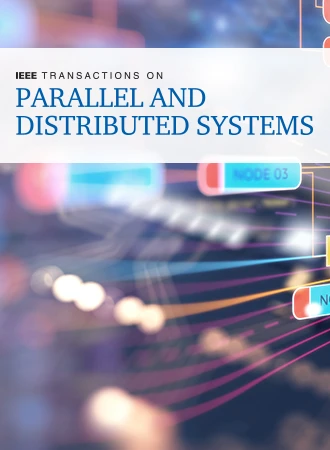G-Learned Index: Enabling Efficient Learned Index on GPU
IF 5.6
2区 计算机科学
Q1 COMPUTER SCIENCE, THEORY & METHODS
IEEE Transactions on Parallel and Distributed Systems
Pub Date : 2024-04-02
DOI:10.1109/TPDS.2024.3381214
引用次数: 0
Abstract
AI and GPU technologies have been widely applied to solve Big Data problems. The total data volume worldwide reaches 200 zettabytes in 2022. How to efficiently index the required content among massive data becomes serious. Recently, a promising learned index has been proposed to address this challenge: It has extremely high efficiency while retaining marginal space overhead. However, we notice that previous learned indexes have mainly focused on CPU architecture, while ignoring the advantages of GPU. Because traditional indexes like B-Tree, LSM, and bitmap have greatly benefited from GPU acceleration, a combination of a learned index and GPU has great potentials to reach tremendous speedups. In this paper, we propose a GPU-based learned index, called G-Learned Index, to significantly improve the performance of learned index structures. The primary challenges in developing G-Learned Index lie in the use of thousands of GPU cores including minimization of synchronization and branch divergence, data structure design for parallel operations, and usage of memory bandwidth including limited memory transactions and multi-memory hierarchy. To overcome these challenges, a series of novel technologies are developed, including efficient thread organization, succinct data structures, and heterogeneous memory hierarchy utilization. Compared to the state-of-the-art learned index, the proposed G-Learned Index achieves an average of 174× speedup (and 107× of its parallel version). Meanwhile, we attain 2× less query time over the state-of-the-art GPU B-Tree. Our further exploration of range queries shows that G-Learned Index isG-学习索引:在 GPU 上实现高效学习索引
人工智能和 GPU 技术已被广泛应用于解决大数据问题。2022 年,全球数据总量将达到 200 ZB。如何在海量数据中高效地索引所需的内容变得非常重要。最近,一种很有前途的学习索引被提出来应对这一挑战:它具有极高的效率,同时保留了边际空间开销。然而,我们注意到,以往的学习索引主要集中在 CPU 架构上,而忽略了 GPU 的优势。由于 B-Tree、LSM 和 bitmap 等传统索引已从 GPU 加速中获益良多,因此将学习索引与 GPU 结合在一起具有极大的潜力,可以实现极大的提速。在本文中,我们提出了一种基于 GPU 的学习索引,称为 G-Learned Index,以显著提高学习索引结构的性能。开发 G-Learned Index 的主要挑战在于如何使用成千上万的 GPU 内核,包括同步和分支发散的最小化、并行操作的数据结构设计以及内存带宽的使用(包括有限的内存事务和多内存分层)。为了克服这些挑战,我们开发了一系列新技术,包括高效线程组织、简洁数据结构和异构内存分级利用。与最先进的学习索引相比,所提出的 G-Learned Index 平均提速 174 倍(并行版本提速 107 倍)。同时,与最先进的 GPU B-Tree 相比,我们的查询时间缩短了 2 倍。我们对范围查询的进一步探索表明,G-Learned 索引比 CPU 多维学习索引快 17 倍。
本文章由计算机程序翻译,如有差异,请以英文原文为准。
求助全文
约1分钟内获得全文
求助全文
来源期刊

IEEE Transactions on Parallel and Distributed Systems
工程技术-工程:电子与电气
CiteScore
11.00
自引率
9.40%
发文量
281
审稿时长
5.6 months
期刊介绍:
IEEE Transactions on Parallel and Distributed Systems (TPDS) is published monthly. It publishes a range of papers, comments on previously published papers, and survey articles that deal with the parallel and distributed systems research areas of current importance to our readers. Particular areas of interest include, but are not limited to:
a) Parallel and distributed algorithms, focusing on topics such as: models of computation; numerical, combinatorial, and data-intensive parallel algorithms, scalability of algorithms and data structures for parallel and distributed systems, communication and synchronization protocols, network algorithms, scheduling, and load balancing.
b) Applications of parallel and distributed computing, including computational and data-enabled science and engineering, big data applications, parallel crowd sourcing, large-scale social network analysis, management of big data, cloud and grid computing, scientific and biomedical applications, mobile computing, and cyber-physical systems.
c) Parallel and distributed architectures, including architectures for instruction-level and thread-level parallelism; design, analysis, implementation, fault resilience and performance measurements of multiple-processor systems; multicore processors, heterogeneous many-core systems; petascale and exascale systems designs; novel big data architectures; special purpose architectures, including graphics processors, signal processors, network processors, media accelerators, and other special purpose processors and accelerators; impact of technology on architecture; network and interconnect architectures; parallel I/O and storage systems; architecture of the memory hierarchy; power-efficient and green computing architectures; dependable architectures; and performance modeling and evaluation.
d) Parallel and distributed software, including parallel and multicore programming languages and compilers, runtime systems, operating systems, Internet computing and web services, resource management including green computing, middleware for grids, clouds, and data centers, libraries, performance modeling and evaluation, parallel programming paradigms, and programming environments and tools.
 求助内容:
求助内容: 应助结果提醒方式:
应助结果提醒方式:


